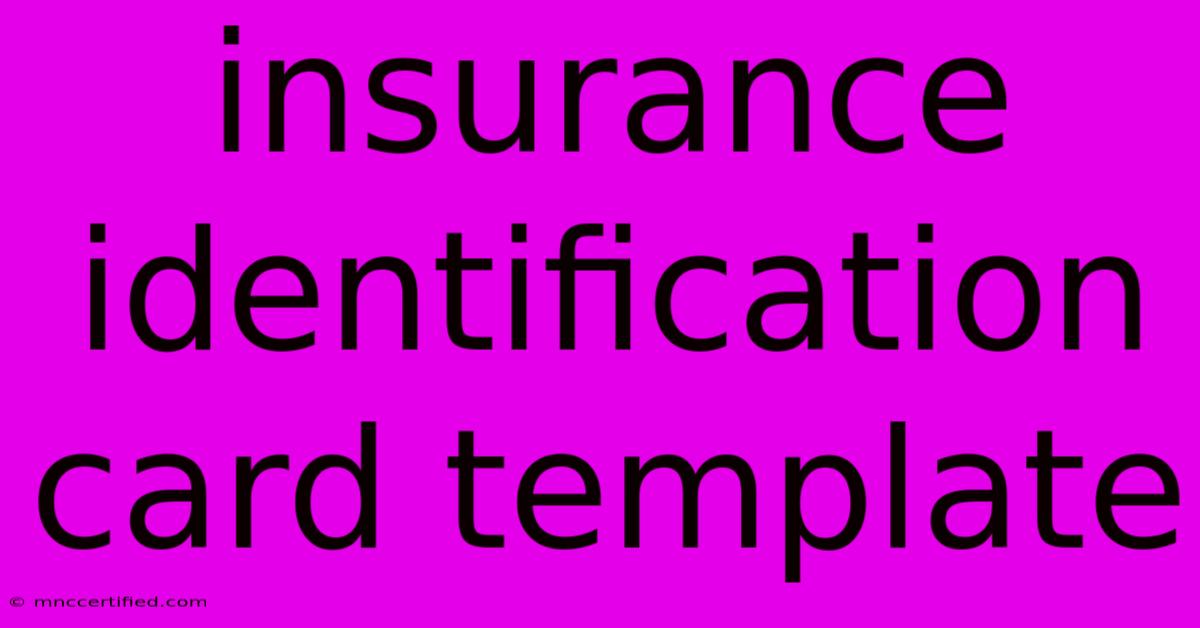Insurance Identification Card Template

Table of Contents
Insurance Identification Card Template: A Comprehensive Guide
An insurance identification card, often called an insurance card, is a small, pocket-sized document that contains crucial information about your health insurance policy. It's essential for accessing healthcare services and ensuring smooth payment processing. If you're looking to create your own insurance identification card template, this guide will walk you through the process.
Understanding the Importance of an Insurance Identification Card
An insurance identification card serves as your gateway to healthcare services. It provides the following critical information:
- Policyholder's Name: Identifies the insured person.
- Policy Number: Unique identifier for your insurance policy.
- Group Number: If applicable, identifies the group your policy belongs to.
- Effective Dates: Specifies the coverage period of your policy.
- Insurance Company Name and Contact Information: Helps providers contact the insurance company for verification.
- Member ID: Your personal identification number associated with the policy.
- Co-pay or Deductible: May display relevant information about your cost-sharing responsibilities.
- Emergency Contact Information: In case of an emergency, providers can reach out to designated contacts.
Key Elements of an Effective Insurance Identification Card Template
Your insurance identification card template should be designed to be:
- Clear and Concise: Easy to read and understand at a glance.
- Visually Appealing: Utilize a professional design with a clear layout and font choice.
- Durable: Choose a cardstock material that can withstand wear and tear.
- Secure: Consider security features like watermarks or holograms to prevent counterfeiting.
Creating Your Insurance Identification Card Template
Here's a step-by-step guide to creating your own template:
1. Choose a Template Design:
- Use a pre-made template: Many online platforms offer downloadable insurance card templates that you can customize.
- Design your own: Utilize graphic design software like Adobe Illustrator or Canva to create a unique template from scratch.
2. Include Essential Information:
- Policyholder Name: Use a legible font size.
- Policy Number: Display prominently and clearly.
- Group Number: Include if applicable.
- Effective Dates: Ensure clear visibility.
- Insurance Company Name and Contact Information: Include full details for easy reference.
- Member ID: Display prominently for quick identification.
- Co-pay or Deductible: Include this information, if relevant.
- Emergency Contact Information: Provide relevant contact details.
3. Add Additional Information:
- Logo: Include your insurance company's logo for brand recognition.
- Barcodes: Consider adding barcodes for quick scanning and verification.
- QR Codes: Include QR codes that link to your company's website or online portal.
- Security Features: Implement watermarks, holograms, or other security measures.
4. Print and Distribute:
- High-quality printing: Ensure clear and legible prints using a professional printer.
- Secure storage: Store templates securely to prevent unauthorized access.
- Distribution: Distribute templates to policyholders through mail, email, or online portals.
5. Customization Tips:
- Use color-coding: Differentiate between different types of cards using distinct colors.
- Include a disclaimer: Add a disclaimer regarding the card's purpose and limitations.
- Personalize the design: Use your company's branding elements for a professional look.
Tips for Optimizing Your Insurance Identification Card Template for SEO
- Use relevant keywords: Include keywords like "insurance card template," "health insurance card," and "insurance ID card."
- Optimize your website content: Create blog posts or FAQs about your card template and the benefits it offers.
- Build backlinks: Encourage industry websites or blogs to link to your template page.
- Promote your template on social media: Use relevant hashtags and share your template on social platforms.
Conclusion
Having an effective insurance identification card template is crucial for enhancing the user experience and simplifying healthcare processes. By following these steps, you can create a professional and user-friendly template that meets the needs of your policyholders. Remember to prioritize clarity, security, and SEO best practices to maximize the impact of your template and build a strong online presence.

Thank you for visiting our website wich cover about Insurance Identification Card Template. We hope the information provided has been useful to you. Feel free to contact us if you have any questions or need further assistance. See you next time and dont miss to bookmark.
Featured Posts
-
Iowa Vs Ucla Leistikows Short Week Analysis
Nov 09, 2024
-
Bad Faith Insurance Attorney San Diego
Nov 09, 2024
-
Paddingtons Journey Finding Family In Peru
Nov 09, 2024
-
Iowa Vs Ucla 2024 Game Prediction And Betting Odds
Nov 09, 2024
-
Federal Raid At Oakes Farms Alfie Oakes Home
Nov 09, 2024